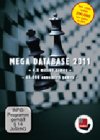 |
ChessBase Reviews |
Last updated 17 January 2011

| index |
CDs, DVDs, Software Part 44

Junior 12 by ChessBase
The name is perhaps deceptive. Playing against Junior is not necessarily something for children, as Garry Kasparov discovered in a match in New York. He was held to a 3-3 draw by the Israeli program. Junior played in its typically dynamic style, greatly surprising the former World Champion with now-famous bishop sacrifice on h2 that forced him to concede a draw. Junior has its own special search techniques and evaluation functions, which makes it different to any other chess program. It is enterprising and entertaining, sacrificing material for initiative whenever it sees a chance, providing new ideas in traditional positions against man or machine. Written by Amir Ban and Shay Bushinsky, Junior has won multiple World Computer Chess Championships, and now, in version 12, its playing strength has been further increased – by around 200 Elo points, compared to the previous version 10 published by ChessBase. You can look forward to a world class grandmaster when you install the new program on your computer.
What you get with Junior 12:
- Junior 12 chess engine (32 bit)
- The latest openings book by GM Alon Greenfeld
- The Fritz 12 GUI
- Photo realistic chessboards in five
- Twelve months free access (Classic) to the world’s biggest chess server Playchess.com
System requirements: Minimum: Pentium III 1 GHz, 1.5 GB RAM, Windows Vista, XP (Service Pack 3), Windows 7, DirectX9 graphics card with 256 MB RAM, DVD-ROM drive, Windows-Media Player 9, internet access (playchess.com, updates and activation). Recommended: PC Intel Core 2 Duo, 2.4 GHz, 3 GB RAM, Windows 7, DirectX10 graphics card (or compatible) with 512 MB RAM or more, 100% DirectX10 compatible sound card, Windows Media Player 11, DVD ROM drive and internet access (playchess.com, updates and activation).

Mega Database 2011 by ChessBase
Once again the best Database going.
The exclusive annotated database. Contains more than 4.8 millions games from 1560 to 2010 in the highest ChessBase quality standard. 65,000 games contain commentary from top players, with ChessBase opening classification with more than 100,000 key positions, direct access to players, tournaments, middlegame themes, endgames. The largest top-class annotated database in the world. The most recent games of the database are from the middle of November 2010. Mega 2011 also features a new edition of the playerbase. As usual, this is where most of the work was done. As the player index now contains already more than 257,000 entries, it made sense to use an adapted playerbase which includes about 270,000 names. Doing this, the photo database was extended as well to contain 32,000 pictures now. Includes: Online Mega-Update 2011: With ChessBase 10 or 11 you can download games for Mega 2011 for the whole year, a total of approximately 200,000! That means your Mega 2011 will remain up to date from January to December.
Mega Database 2011:
- 4.8 million games
- 65.000 annotated games
- Playerbase with 270,000 names and 32,000 pictures
- weekly online update: 200,000 games until 31.12.2011
System requirements: 1 GHz Pentium PC, Windows7, Windows Vista/XP, 512 MB RAM, DVD-ROM drive, ChessBase 10, ChessBase 11, ChessBase Light 2009 Premium, Internet.

Black Repertoire Against 1.e4
Vol 2 - Open Games by Jan Gustafsson
The open games after 1.e4 e5 offer White a huge choice. Part 1 of this series covered the main line Spanish and recommended the Marshall Attack - but what to do against the Exchange Spanish, the Scotch or the Italian Game?
The DVD answers those questions and many more. Based on his own Black repertoire, GM Jan Gustafsson provides you with all the tools you could need to succesfully combat 1.e4 with 1...e5! Learn why 4...Nf6 spells trouble for Scotch enthusiasts, how to deal with the Evans Gambit and why the King’s Gambit should be accepted. Popular lines like 5.d3 in the Spanish are covered, just like the Four Knights, the Ponziani or the Vienna Game, exotic lines like 1.e4 e5 2.Bc4 Nf6 3.d4 get their treatment as well. Many novelties and improvements over existing theory are to be found along the way. After watching this DVD you will no longer fear your opponent’s deviations from a main line Spanish, in fact, you will positively hope for them! In 19 chapters with a running time of 5h 34, you can complete your 1.e4 e5 repertoire.